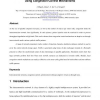Free Online Productivity Tools
i2Speak
i2Symbol
i2OCR
iTex2Img
iWeb2Print
iWeb2Shot
i2Type
iPdf2Split
iPdf2Merge
i2Bopomofo
i2Arabic
i2Style
i2Image
i2PDF
iLatex2Rtf
Sci2ools
PE
2008
Springer
2008
Springer
Improving the performance of large interconnection networks using congestion-control mechanisms
As the size of parallel computers increases, as well as the number of sources per router node, congestion inside the interconnection network rises significantly. In such systems, packet injection must be restricted in order to prevent throughput degradation at high loads. This work evaluates three congestion control mechanisms on adaptive cut-through torus networks under various synthetic traffic patterns. A range of network parameters (radix, number of injection channels, deadlock avoidance method) is used to cover the current network design space. Traffic is generated using bursts of data exchanges (instead of a Bernoulli process) to reflect the synchronized nature of data interchanges in parallel applications. Simulation results show that large networks perform their best when most network resources are dedicated to in-transit traffic. Besides, local congestion control mechanisms are nearly as effective as the more costly global ones for both uniform and non-uniform traffic pattern...
Related Content
| Added | 14 Dec 2010 |
| Updated | 14 Dec 2010 |
| Type | Journal |
| Year | 2008 |
| Where | PE |
| Authors | José Miguel-Alonso, Cruz Izu, José-Ángel Gregorio |
Comments (0)

